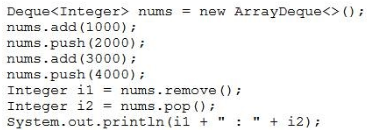Given the code fragment:

What is the result?
Given the code fragment:

What is the result?
The given code uses an ArrayDeque which functions as a double-ended queue. The methods used (`add`, `push`, `remove`, and `pop`) manipulate the queue from both ends depending on their function. `add()` adds elements to the tail (end) of the deque, and `push()` adds elements to the head (front). The `remove()` method removes and returns the head of the deque, while `pop()` also removes and returns the head. After executing the given operations, the sequence of numbers in the deque is: 4000 (head), 2000, 1000, 3000 (tail). Therefore, `remove()` and `pop()` both operate on the head, resulting in 4000 being removed first and then 2000. The final output will be '4000 : 2000'.
Answer is A, tested Deque<Integer> nums = new ArrayDeque<>(); nums.add(1000); System.out.println(nums); nums.push(2000); System.out.println(nums); nums.add(3000); System.out.println(nums); nums.push(4000); System.out.println(nums); Integer i1 = nums.remove(); System.out.println(nums); Integer i2 = nums.pop(); System.out.println(nums); System.out.println(i1 + ":" + i2);
A,tested
A is correct. Tested. Firstly 1000 is added (at the back), then 2000 is added to front, then 3000 is added to back and finally 4000 to front, so deque looks like 4000-2000-1000-3000 and remove and pop do the same thing which is take value from from of deque and those values are 4000 and 2000 which are printed.
A, tested
B is correct
Sorry, A is correct